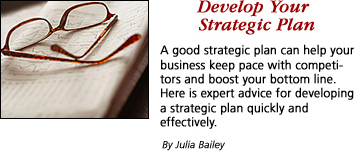|
Strategic planning is critical to the survival and growth of your business in both the long- and short-term. From establishing a solid foundation to ensuring that your company is on the right course, strategic planning allows you to stay in control. But, where do you start? What should your strategic plan include? And how often should you review it? What Is It?
Why Do You Need It? Even if your business is very small, you need to develop a strategic plan. “It’s important for small businesses, because the environments [in which small businesses are competing] are very unforgiving,” says Keith McFarland, a former Inc. 500 CEO who now leads McFarland Strategy Partners, a strategic management consultancy based out of Sandy, Utah. “Typically, small companies are going up against better-positioned, larger competitors that have advantages like scale and scope. So, strategy is as important.” And when you consider how technology drives the pace of change in the marketplace, having a solid strategic plan in place can help you foresee changes and opportunities in the market and identify areas in which you need to improve. The Process To create a strategic plan that will prove to be a valuable playbook for the future of your business, it’s important to include people from all areas of your company. “You want people who are out touching a whole bunch of parts of your company so you’ve got distributed knowledge,” McFarland says. “After all, the more brains working on a problem, the better the result.” Establish a Purpose. The process should begin with a definition of your business purpose or mission. This is a brief global statement of what your business is all about. And it’s something that is surprisingly difficult for some businesses. “One reason that small businesses don’t do well is because they don’t know what they’re about,” says Judith Kautz, a former business professor and computer consultant who now publishes Small Business Notes. “Even if you’re a small retail sporting goods store, for example, are you going to gear it for kids? You want to know where you want to go with your particular business.” Look at the Big Picture. It’s important to assess outside factors that affect your business, such as the economy, your market and your competition. Then, take a closer look at where your business sits in its environment in order to identify your biggest challenges and opportunities, using a SWOT analysis. Remember not to belabor your SWOT analysis. “I love SWOT, but a lot of people get totally caught up in it,” Kautz says. “I think it may be better to put it together for the long term and touch base with it occasionally. I don’t see it as an everyday planning tool, but more like your mission statement, something you revisit occasionally.” Set Goals. The best way to get at the organization’s goals is to brainstorm in small and medium-sized groups. “You’ll end with hundreds of possible things you could accomplish,” Kautz says. Because you can’t do everything, you’ll need to make decisions about which of the goals you’re going to pursue. “One of my favorite tools is the ‘Goals Grid,’ developed by Frederick Nickols,” Kautz says. “It provides an easy way to decide which ones you want to toss and which to keep.” From your organizational goals, you can then set strategic objectives that are achievable and measurable. Develop Action Plans. This is the point at which you set and assign responsibilities for your objectives and target dates for achieving them. If your business is large enough, you can group action steps into categories, such as marketing, sales or operations. Assign a person to be accountable for each action and determine when that action should be complete. Implement the Plan. This is often where a disconnect occurs in busy companies. If you don’t follow through, however, you’ve wasted your time planning. Build checkpoints into your schedule and monitor your progress toward your objectives on a regular basis. Plan Today The strategic planning process has come a long way since the 1960s, when it hit the height of popularity with big businesses. “Then, it involved a cerebral, theoretical approach to thinking about the future when markets didn’t change very much and boundaries between industries were clear,” McFarland says. “Today, things change so fast that traditional tools of strategic planning are not as useful.” What small businesses need today, according to McFarland, is an approach to strategic planning that “reflects the reality of today’s volatile and hypercompetitive markets,” which he adds thrive upon uncertain product life cycles and an increasingly international business climate. McFarland’s solution? “A company can build a strategy in 48 hours that’s 90 percent as good as one they can produce in three months,” he says. The goal of his process, called Rapid Enterprise Development (RAD), is to develop a consensus on where the company wants to be. “I typically hold people to about a three-year time frame, with different levels of granularity and a series of less ambitious 90-day goals to get there.” Internet businesses demand a much more intense strategic cycle. “Ninety percent of my clients get together every quarter and do what we call a ‘strategy reset,’ where they look at what we have learned in the last 90 days and determine ways to adapt our strategy,” he adds. Plan It Quickly Whether you buy into the need for speed, don’t let your strategic planning process take over your business. “This can often become the whole purpose of companies,” Kautz says. “They sometimes spend incredible amounts of time on this. Do it fairly quickly—no more than a month—because you can always fine-tune it. You could spend huge amounts of time and money. That’s not productive. You really should be taking care of business.” |
|
 |
|||
